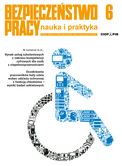Primary rights and obligations of workers with disabilities and their employers
Martyna Ostrowska, Aneta Michcik
Economic activity in the lives of people with disabilities is very important. However, the awareness of both employers and people with disabilities of their relevant rights, obligations and facilities is still limited. That is why education on instruments supporting the employment of people with disabilities is so important. A public discussion on the benefits, facilities and employers' obligations and the rights of people with disabilities is also necessary. An improved situation in the labor market of the latter should result from that discussion.
The requirements and recommendations for the microclimate parameters, the thermal comfort and the thermal load of disabled employees
Magdalena Młynarczyk
Thermal comfort in the workplace translates directly to their well-being, to increase concentration during the work and to increase safety and efficiency. However, should be noted, that people with different disabilities may feel thermal comfort in other range of microclimate parameters than non-disabled people.
This article contains general information on the requirements and recommendations for the microclimate parameters thermal comfort and thermal load for workers with disabilities.
Acoustic signalisation in the work environment of the disabled persons
Jan Radosz, Paweł Górski, Rafał Młyński
Auditory signals in the work environment can be divided into information signals and safety signals. Safety signals provide essential information to maintain the safety and health of workers, including risks in the work environment (fire, pollution), failure of devices, moving vehicles, etc. Information signals have no direct impact on the safety of the workers, but improve comfort and even allow to perform some activities. They are particularly important in the case of employees with sight disabilities. For persons with hearing disabilities auditory signals must be complemented by light signals. The article presents the issues and requirements for auditory signals in the design of objects and spaces and adaptation of workstations for people with disabilities. The article also raises issues of auditory signals complemented by light signals.
Adaptation of electric lighting of the work environment of visually impaired persons
Andrzej Pawlak
The article discusses adaptation of buildings, and rooms and workstations located both inside and outside buildings in the area of electric lighting for visually-impaired people. This adaptation is based on a proper selection of lighting parameters such as illuminance, uniformity ratio of illuminance, colour rendering index, colour of light (colour temperature), glare, and the flickering light ripple and strobe effect depending on the type of visual disability. Because there are no specific requirements for the above parameters in current standards on lighting, this paper suggests recommendations and technical solutions aimed at improving working conditions of the visually-impaired workers. Particular attention is paid to the design and specifications of local lighting luminaires. This paper also presents issues related to electric lighting of cabin lifts. Examples of features that improve the quality of lighting in rooms and workstations for visually-impaired people are presented, too.





























